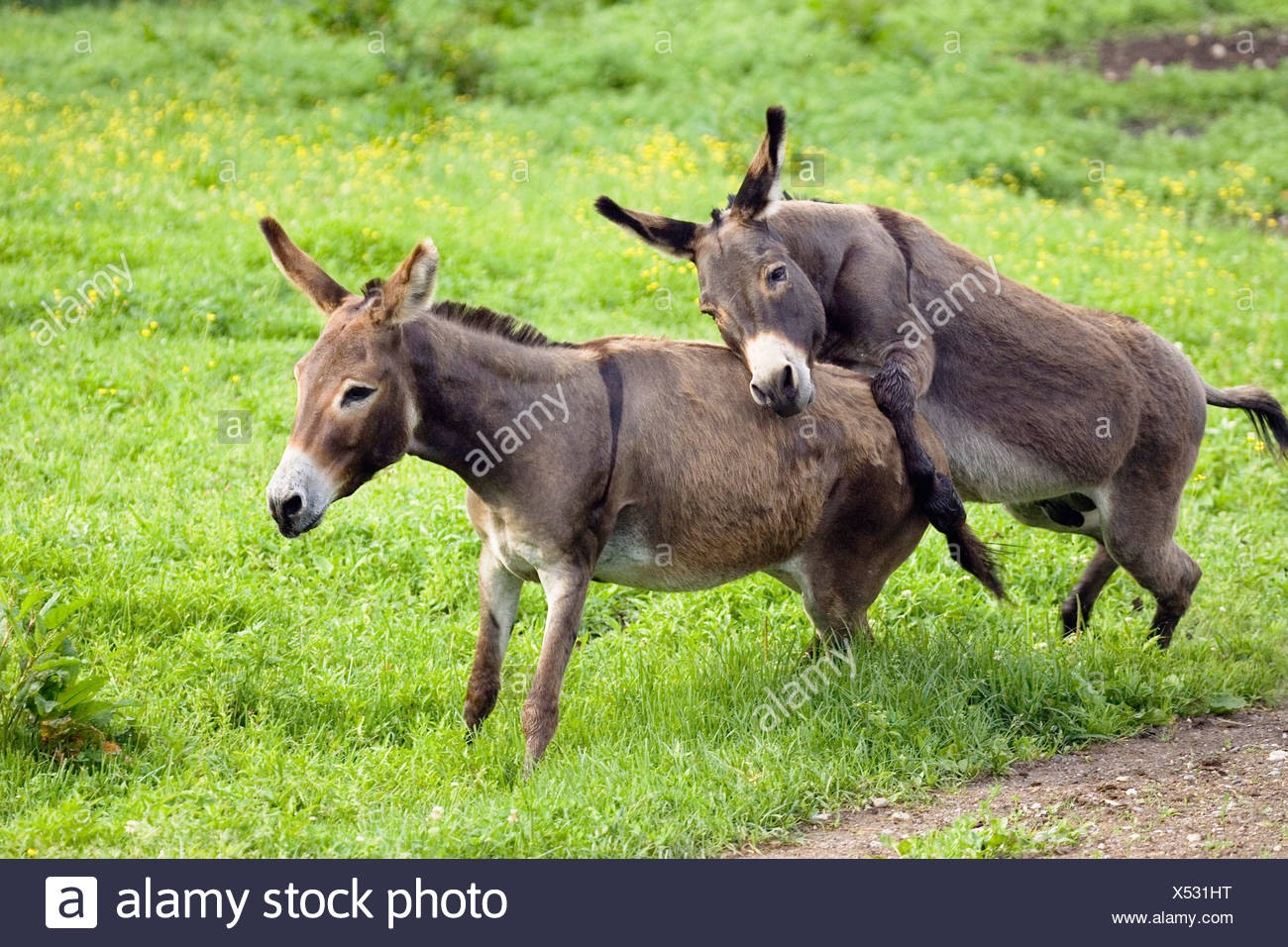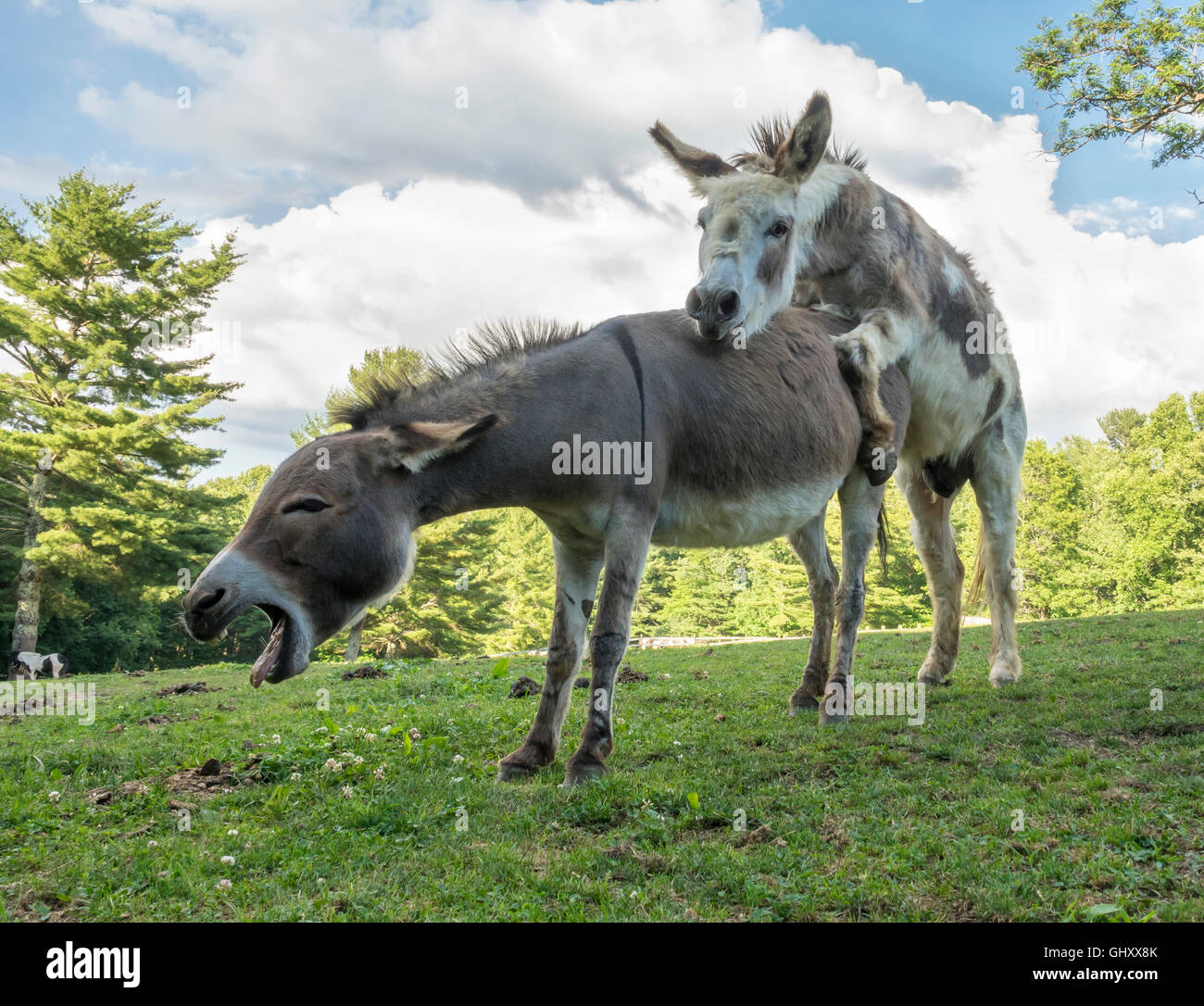Have you ever pondered the secrets of the donkey's world? The mating rituals of these seemingly simple creatures are, in reality, a captivating spectacle of intricate behaviors, driven by instinct, hormones, and a delicate dance of social cues.
The world of donkey reproduction is a fascinating realm, far more complex than one might initially assume. The process itself, at its core, is a natural act, driven by the interaction between a male donkey, known as a jack, and a female donkey, often referred to as a jenny or jennet. But, this seemingly straightforward interaction is but the surface of a much deeper, more complex interplay of biological and environmental factors. African donkey mating, in particular, holds a cultural significance, woven into the fabric of communities that rely on these resilient animals.
The donkey's reproductive cycle is primarily governed by the estrous cycle, a recurring period when the jenny is receptive to mating. This cycle, critical to understanding the breeding process, is typically observed every 21 days, lasting for about 7 to 10 days. During this receptive phase, the jenny displays specific behavioral and physiological signs, signalling her readiness to the attentive jack. However, the success of reproduction hinges not only on the receptive state of the jenny but also on the union of a jack and a willing jenny during this particular phase of the cycle.
- Diatoya Latest Updates Community Insights What You Need To Know
- We Did Not Find Results Related Queries Insights
| Feature | Details |
| Common Name | Donkey |
| Scientific Name | Equus asinus |
| Gestation Period | Approximately 12 months (365 days) |
| Estrous Cycle | Recurring cycle of approximately 21 days |
| Duration of Estrus | Approximately 7 to 10 days |
| Breeding Season | Can vary depending on climate and location, but generally, donkeys are able to breed throughout the year. However, peak breeding activity often occurs during periods of optimal environmental conditions. |
| Mating Behavior | Jack initiates courtship by approaching the jenny, often exhibiting vocalizations, sniffing, and pawing. The jenny may signal her receptivity through various behavioral cues. |
| Offspring | Typically, one foal is born per pregnancy. Twins are rare. |
| Hybrid offspring | Mule (jack + mare), Hinny (stallion + jenny) |
| Conservation Status | Various breeds have different conservation statuses, ranging from Least Concern to Critically Endangered. |
A deeper dive into the donkey's reproductive cycle reveals the influence of various factors that shape the process. Age, health, and environmental conditions significantly contribute to the overall mating success. The animal's health, encompassing both physical well-being and freedom from disease, plays a pivotal role. Environmental factors, including climate, seasonal changes, and availability of resources such as feed and water, can also have a noteworthy impact. Breeders must be knowledgeable about these elements to maximize the chances of successful breeding outcomes, ensuring the well-being of their donkeys and contributing to the long-term health of the population. The social dynamics, including the individual donkeys' social position and their ability to compete for mates, further adds layers to the process, and influence the outcome.
What are the observable signs that a female donkey, a jenny, is in "heat", ready and willing to mate? This is a vital question for those involved in donkey breeding. The answer lies in observing the behavioral and physiological cues that signal the jenny's receptivity to the jack. During her estrous cycle, a jenny will display a range of changes. These include alterations in her behavior, such as increased restlessness, frequent urination, and a heightened interest in the presence of a jack. Physically, the jenny might exhibit swelling of her vulva, along with a change in the discharge, indicating that she is at the appropriate point in her cycle for conception. Recognizing these signs is key for successful breeding.
Hormones, the body's chemical messengers, play a vital role in this process. They orchestrate the timing and execution of donkey mating. Like other animals, donkeys are regulated by a delicate hormonal balance that guides the physiological processes involved in reproduction. These hormones act like the conductors of an orchestra, signaling to the body when to prepare, when to be receptive, and when to potentially sustain a pregnancy. The intricate interplay of these chemical messengers ensures that all the elements of the mating process are synchronized, from the jenny's receptivity to the jack's behavior.
- Equations Explained A Comprehensive Guide To Solving
- Find Movies Shows In India Justwatch Avoiding Mkvcinemas
The fascinating hybrid offspring of donkeys and related species, like horses, should not be overlooked. The mule, produced by mating a male donkey (jack) with a female horse (mare), inherits the size and speed of horses while retaining the strength and endurance of donkeys. Mules have long been prized for their resilience and versatility. On the other hand, the hinny results from a male horse (stallion) mating with a female donkey (jenny). Hinnies are generally smaller than mules, and often resemble donkeys more closely in appearance. Both hybrids demonstrate the fascinating possibilities and the complexities of interspecies reproduction.
Donkey mating, therefore, is a complex dance of instinct and ritual, showcasing a fascinating blend of physical and social cues. While the mating process might not be as overtly flamboyant as that of some other animal species, it represents a compelling display of natural selection and survival. Each element, from the individual donkeys health to the environmental factors influencing the breeding process, contributes to the long-term health and vitality of the species. The study of the donkey's mating habits and reproductive success continues to inform the practice of animal husbandry and aids in conservation efforts.
The influences of environment and seasonality on mating success are also crucial. Breeders and those who manage donkey populations must be attuned to environmental shifts. The environment directly impacts fertility, gestation periods, and overall health. The seasonal changes and their effects, which includes the availability of resources, influence the breeding behaviors of donkeys. These factors may play a significant role in the mating process. Careful monitoring and environmental management can significantly improve the chances of successful breeding and ensure the well-being of donkeys.
Understanding the nuances of donkey mating requires acknowledging the social structures that exist within donkey populations. The social position of individual donkeys and their ability to compete for mates can influence the outcome. Dominant donkeys may have more access to potential mates, influencing the genetics and ultimately the success of future generations. This highlights the importance of understanding not only the biology but also the social dynamics within these herds. Sound husbandry practices are critical for ensuring that all donkeys have the opportunity to participate in the breeding process, thus preventing genetic bottlenecks and maintaining a healthy gene pool.
In conclusion, donkey mating is an intricate blend of instinct, biology, and environment, demonstrating the multifaceted nature of animal reproduction. From the intricate dance of hormones to the influence of environmental conditions and social dynamics, every element plays a critical role in this fascinating process. By understanding these elements, we can better appreciate the beauty of the natural world and safeguard the well-being of these resilient animals that play important roles in many cultures and communities around the world.


